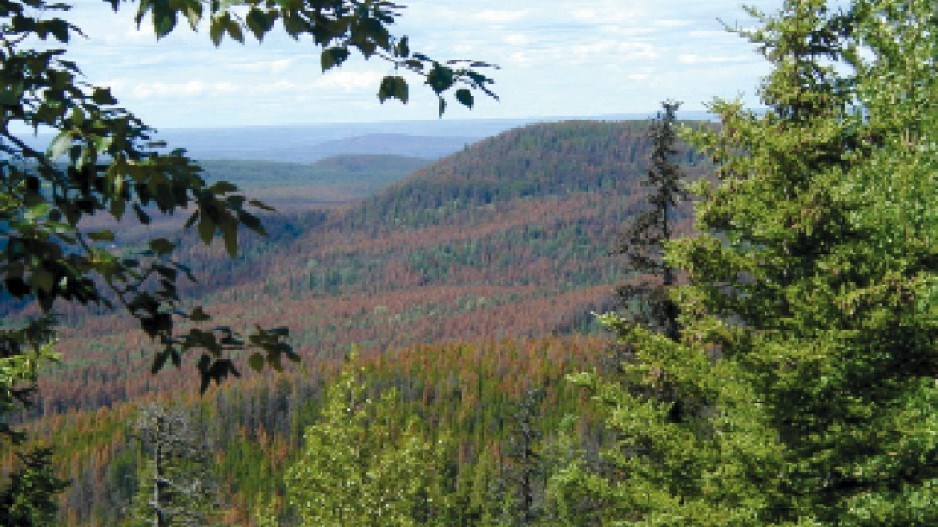A government committee looking into ways to increase dwindling timber supply to Interior forests decimated by the pine-beetle epidemic is short-sighted, short on time and may be a short fuse to igniting another “war of the woods,” say industry observers.
Among the ideas being considered is harvesting currently prohibited areas that could require “rebalancing” important environmental and social considerations, according to a recently released committee discussion paper that precedes community open houses in June and July. Since the infestation began in 1999, about 10 million hectares that support timber harvesting have been affected, says the paper.
A government document made public earlier in the year forecasted 12,000 jobs were at risk and suggested the province consider logging areas currently managed for their biodiversity, wildlife and scenic values. However, any talk of logging protected areas such as old-growth forests gives the industry, still scarred from Greenpeace battles in the ’80s and ’90s, fits of anxiety.
“I don’t want the committee to come up with any recommendations that would harm our environmental reputation,” said John Allan, president and CEO of the Council of Forest Industries. “Through the ’90s we have worked long and hard with government to eliminate the war of the woods to stem market boycotts. We’ve got a very good reputation internationally now for forest practices and I don’t want to see anything done that would negatively impact that.”
Bob Simpson, independent MLA for Cariboo North and former NDP forestry critic, is more succinct.
“If we get any kind of buzz that we’re undermining our sustainable forest management, then this industry can go to hell in a hand-basket awfully fast,” he said.
The government discussion paper forecasts that in 10 to 15 years, provincial timber supplies will fall at least 20% below pre-infestation levels for the foreseeable future.
However, allowable cut levels have been elevated throughout the Interior in order to salvage as much wood as possible before trees were destroyed by the mountain pine beetle.
The significantly higher level of cut was never considered sustainable, said Simpson. As such, companies with foresight invested capital into improving operating efficiencies to help offset the likely increase in cost of lumber when supply becomes scarcer.
“[Members of] the industry here were eyeballing each other to see who would make the smart investments to survive the eventual downturn in the cut,” said Simpson. “The industry is now concerned about what the government is attempting to do by trying to flow more timber to them. They’re actually negating their strategic investments.”
Tasked to complete a report by August 15, the committee doesn’t have the necessary time to fully address long-term issues of timber supply and quality, as well as community transition, said Allan.
He wants the committee to focus less on the short-term emergency of finding “bits and pieces of timber supply to fibre up a new mill in Burns Lake” in what is inevitably a contracting industry. He expects more mill closures lie ahead.
“We are an international player in the market for forest products. We need to be competitive. I don’t want to see the committee come up with recommendations that would prop up mills that should otherwise close,” said Allan. “We need an orderly, thoughtful economic transition to alternate forms of employment and industrial activity in some of these communities that are going to get hit with timber supply shortfall.”
MaryAnne Arcand, executive director of the Central Interior Logging Association, said 75% of job-loss predictions have already occurred. She said her membership doesn’t want protected areas opened up and is more focused on new thinking with the current timber land base.
“There’s certainly some innovative things we can do. We can get better use of the fibre that is there and enhanced silviculture practices to help regrowth accelerate,” said Arcand. “Let’s look at doing something different with the timber that is out there, like value-added manufacturing.
Some of those things that we don’t even think of because we’ve been so locked into this model of spruce, pine, fir and two-by-fours for a century. It’s time to take the opportunity to really rethink how we harvest and what we’re harvesting.”
Demand for timber supply has also been somewhat tempered. The U.S housing market was booming previous to the sub-prime mortgage crash of 2008. Annual lumber production for the B.C. interior was just over 15 billion board feet at its peak in 2006. After bottoming out to 8.5 billion feet, China’s construction needs have brought current production to 10.5 billion board feet, said David Elstone, an analyst with ERA Forest Products Research.
“Lumber production in my lifetime likely won’t ever get back up to the peak because there won’t be enough timber supply available due to the pine beetle. I think we might get back up to somewhere between 11 and 12 billion feet and maybe for a short time above that,” he said. •




